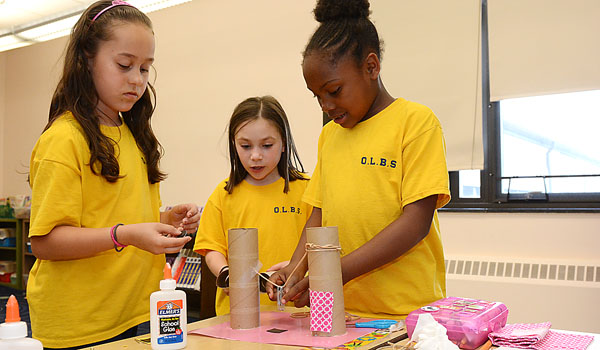Development coordinator helps STREAM schools to 'Gear Up' engineering
by PATRICK J. BUECHI
With the STREAM initiative flowing along nicely at area Catholic schools, the diocesan Department of Catholic Education will add an engineering-focused element into the mix.
Gear Up will teach the seemingly complex engineering design process in a way even kindergarten students can grasp. The Next Generation Science Standards calls for elevating the engineering design process to the same level of scientific inquiry.
"It has a lot of value in teaching the kids higher-level thinking skills. It teaches them how to problem solve," said Shelly Reidy, coordinator for professional development for the Catholic Ed Department. "Think about how jobs have changed. The jobs that our kids will be doing when they graduate from college, when they're in their 40s and 50s. Those jobs aren't around yet. So, you can't teach them skills-wise specifically for a job, but we can give them the higher-level thinking skills - the adaptability, the problem solving. If you look at 21st-century skills, they are critical thinking, communication, collaboration and creativity. Those are what we need to help develop in our students, and this is a mechanism to do that."
Gear Up, which has already been introduced to the 10 STREAM pilot schools, takes just a few days to implement. The program uses an engineering design loop that gives a step-by-step process for problem solving. First students must determine what the problem is. Next they brainstorm solutions. Then they create the solution they think will work best. Next they test that solution. Finally, they evaluate the solution.
"A lot of times teachers do stuff, but they don't explain what the process is," Reidy said. "They're kind of hoping the kids get it just by modeling. This is explicitly teaching it."
Reidy, who taught math at St. Gregory the Great School in Williamsville before joining the STREAM team, said her most successful students were not the ones with the right answers, but the ones who went back to figure out how they got the wrong answers.
"These are life skills. You always want people to have that meta cognition where they're thinking about their thinking and they're thinking about what they did," she explained.
Students will also create a guided portfolio, where they write out problems in their own words so the teachers can make sure they fully understand what they need to solve.
"Now they're having to read the problem, digest it, process it, come up with their own words, and really understand it. If you ever taught kids, they just skim. They don't really read. This forces them to do it," Reidy said.
Some teachers may need time to get used to this new way of teaching. Lecturing is possibly the least effective way of to impart information to students. Reidy prepared teachers during a professional development day in March.
"We talked them off the cliff. Have you ever taught someone to edit a paper? You've been doing it. Have you taught your kids problem solving in math? You've been doing this," Reidy said.
One teacher liked the idea so much, she wanted to use the design loop to deal with two boys who fought in class, hoping to come up with a better solution than fisticuffs.
Students receive a scoring in rubrics, or grading based on specific criteria, rather than as a right or wrong answer. In one project, students design a chair that must be a specific size and hold a certain weight. Even if the chairs can't hold the weight, if a student followed the design loop properly he or she can still receive a good grade.
"It levels the playing field for students," Reidy said. "Everyone knows who the book smart students are. Your kids who are good problem solvers, who are good collaborators, this is where they excel. Now everybody comes to the table with something to offer. It is no longer, 'You're smart and I'm not.'"
Reidy researched and developed the program and worked with STREAM Coordinator Jean Comer to fit into the STREAM curriculum.
"We had looked at a lot of engineering design loops and put this one together, merging stuff we had seen, kind of our best of. Then my job was to teach the teachers," said Reidy.
She continues to coach teachers, visiting STREAM schools and teaching the teachers who will bring the Gear Up program into their classrooms, so that they will be more comfortable with the engineering design process.
"She went through the design process and made sure we understood each step of the engineering design process. She didn't want us to make a sample for the kids. She wanted them to have a very open mind about their design," said Katie Bishop, STREAM coordinator at St. Mary School in Swormville.
Reidy even brought in two bins full of popsicle sticks, glue, and poster board for the teachers.
"I think she's one of those people who goes above and beyond for the good of the students," said Bishop. "She has a lot of enthusiasm for teaching, in particular engineering design. She is, I think, the perfect person to be in charge of this E in STREAM."
Business First named Reidy a "Teacher of Merit" in 2014 for her work teaching seventh- and eighth-grade math at St. Greg's. The North Tonawanda High School graduate earned a bachelor's degree from the Rochester Institute of Technology and a master's in education from the University at Buffalo.




